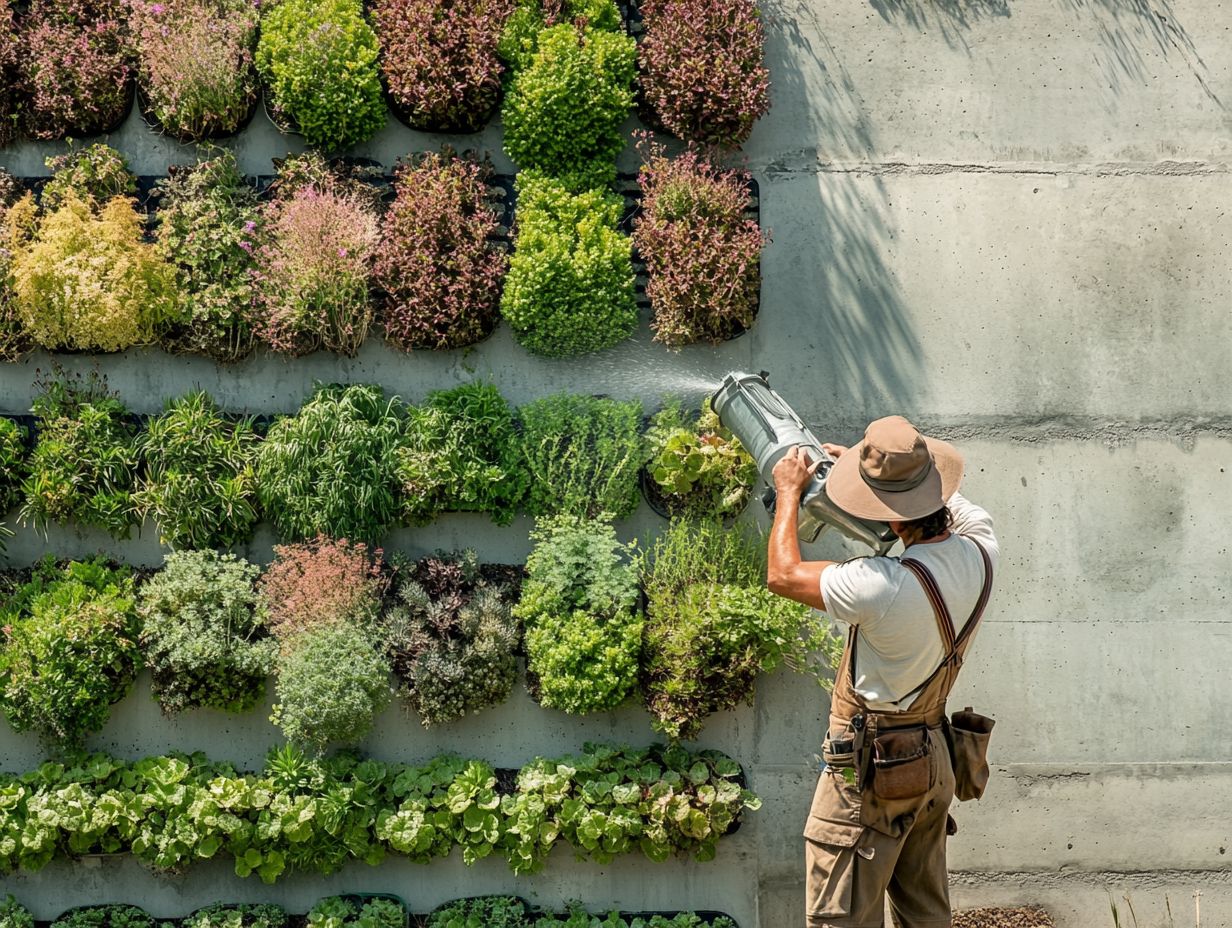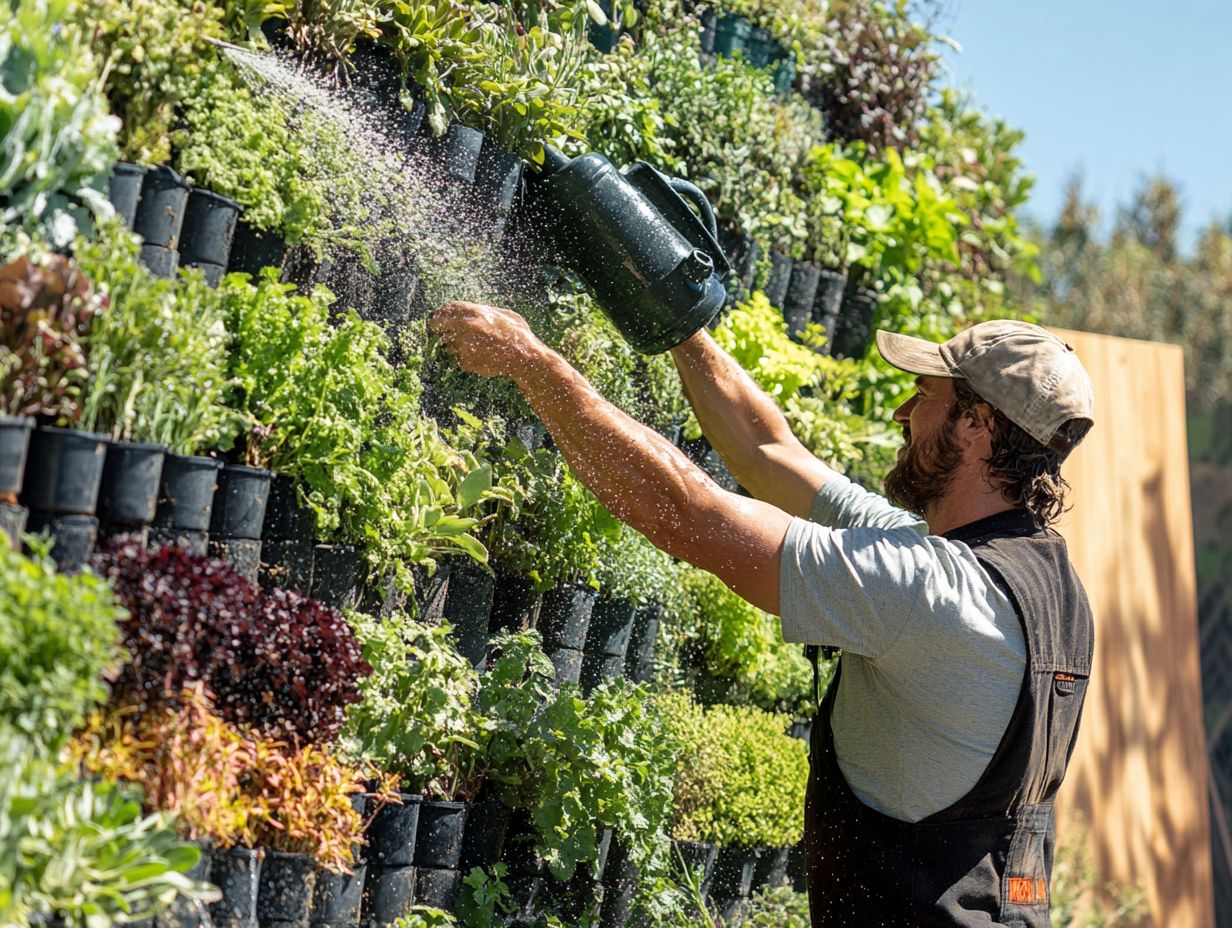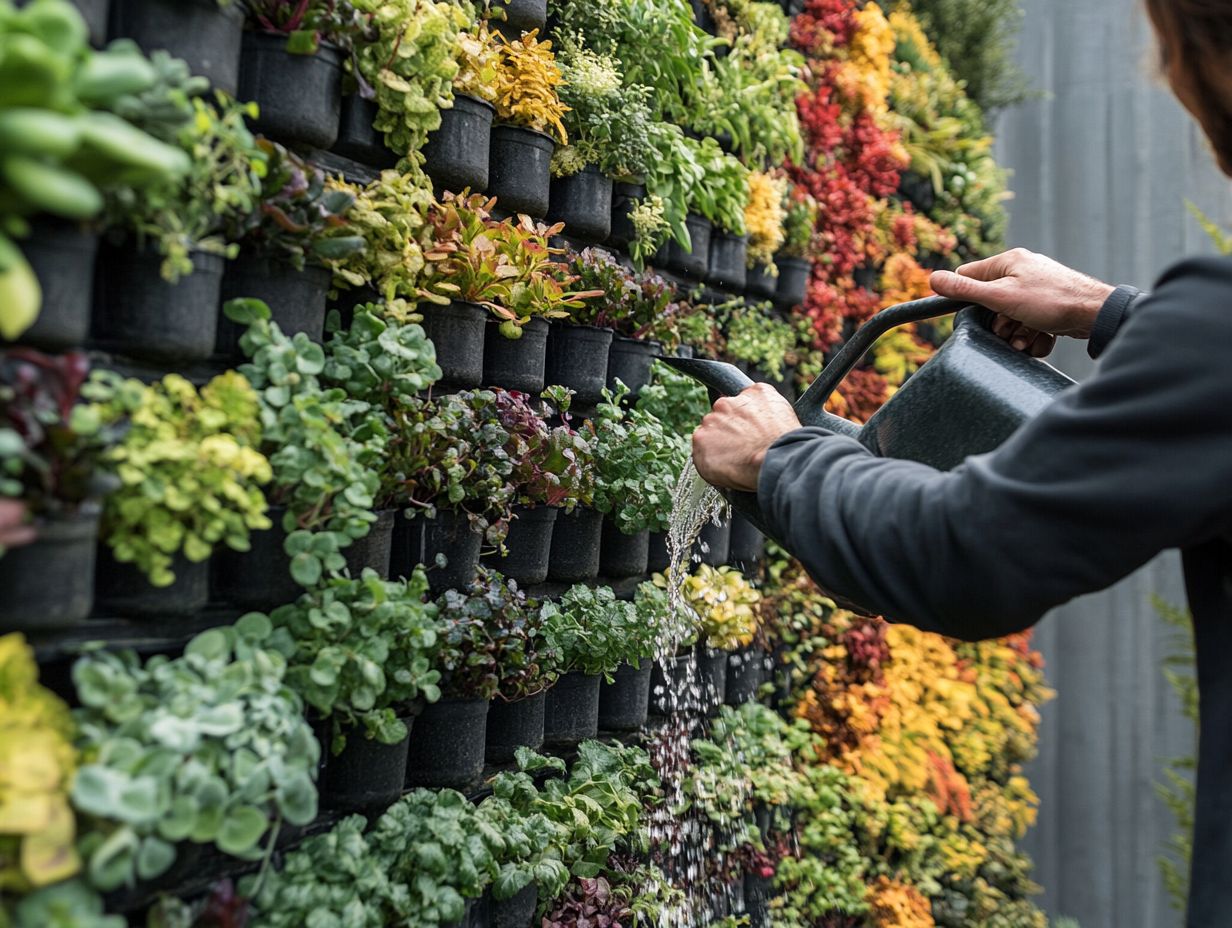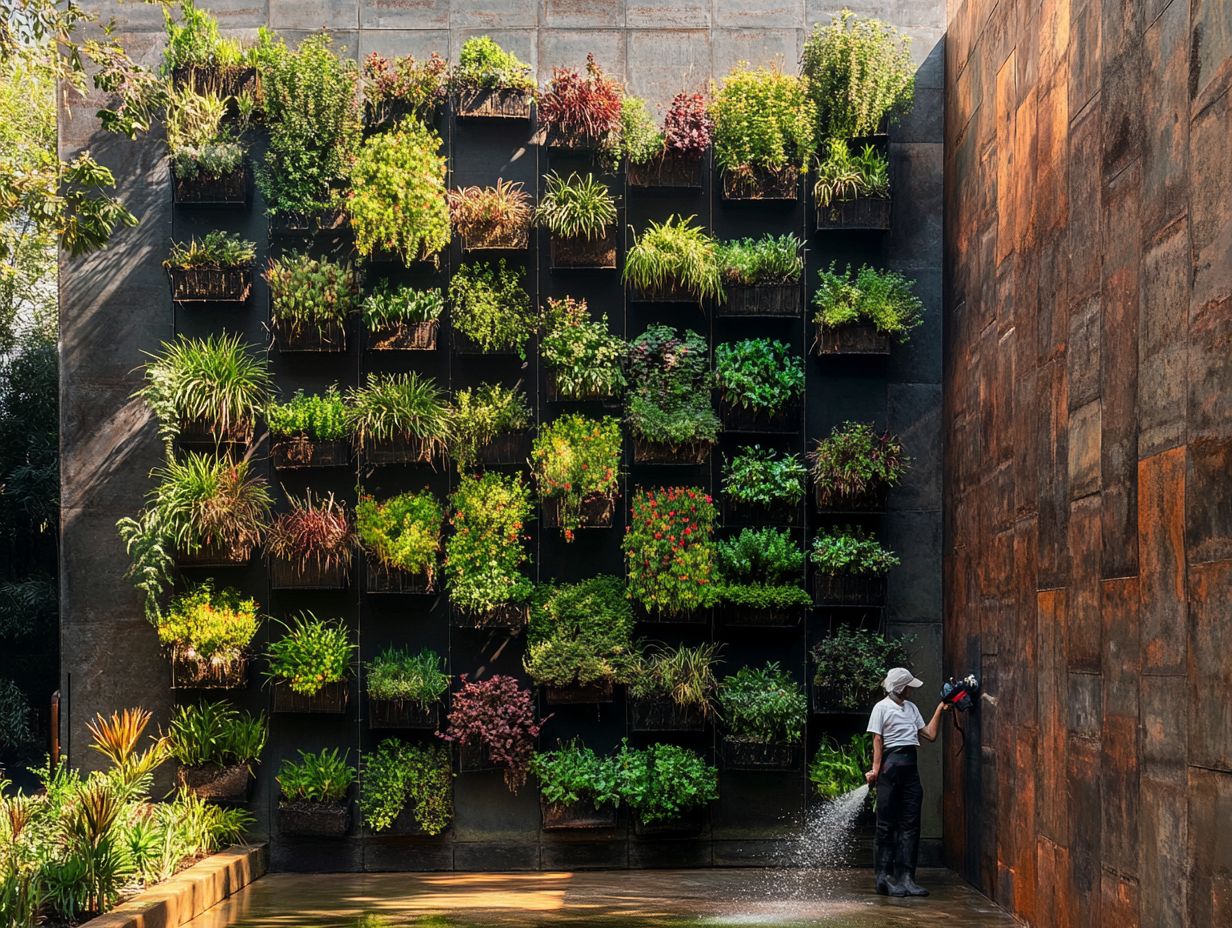Best Practices for Vertical Drought Gardening
Water conservation is crucial today. Vertical gardening is a smart, sustainable choice for urban gardeners.
This innovative approach maximizes your limited space and promotes efficient water use. By focusing on drought-tolerant plants, you can enhance your garden’s beauty. This guide helps you select the right plants and maintain a thriving vertical garden.
Explore creative gardening techniques and make a positive impact on the environment!
Contents
- Key Takeaways:
- Understanding Vertical Drought Gardening
- Benefits of Vertical Drought Gardening
- Choosing the Right Plants for Vertical Drought Gardening
- Preparing for Vertical Drought Gardening
- Building Your Vertical Drought Garden
- Maintaining Your Vertical Drought Garden
- Troubleshooting Common Issues
- Frequently Asked Questions
- What is vertical drought gardening?
- Why is vertical gardening beneficial during drought?
- What are some best practices for vertical drought gardening?
- Can any type of plant be grown in a vertical garden during drought?
- How do I maintain a vertical garden during a drought?
- What are some tips for successful vertical drought gardening?
Key Takeaways:

- Make the most of your space and use less water with vertical gardening techniques.
- Select drought-tolerant plants and climbing varieties for success.
- Keep your garden thriving with proper maintenance and pest management.
Understanding Vertical Drought Gardening
Vertical drought gardening combines vertical gardening techniques with drought resilience, allowing you to grow vibrant, sustainable gardens. To learn more about this method, check out our guide on how to create a sustainable drought garden in urban settings where space is limited.
This method uses vertical structures like wall containers and garden arches to optimize space and beautify your apartment. It also enhances environmental sustainability by improving air quality and promoting biodiversity.
By prioritizing drought-tolerant plants such as basil and rosemary, you can nurture healthier plants that require less upkeep. This is an ideal solution for modern urban gardeners.
What is Vertical Drought Gardening?
Vertical drought gardening focuses on growing plants in a vertical arrangement while conserving water and encouraging drought resilience with effective strategies.
This technique not only makes the most of limited space but also promotes effective irrigation methods. Using wall planters, vertical trellises, or modular planting systems, you can grow plants that thrive in dry conditions.
Consider incorporating succulents, drought-tolerant herbs like rosemary and thyme, and climbing plants such as grape vines and cucumbers. These plants flourish with minimal water. Unlike traditional gardening, which requires extensive soil and significant watering, planning your garden for drought seasons directs water precisely to the roots, using drip or funnel irrigation to maintain soil health.
This method not only benefits your plants but also helps the planet!
Benefits of Vertical Drought Gardening
The advantages of vertical drought gardening extend beyond aesthetics; they provide remarkable benefits in space optimization, environmental sustainability, and pest management. For urban gardeners, this approach is an effective way to maximize yields in limited spaces while fostering biodiversity, especially when utilizing drought gardening tips for sustainable practices.
Maximizing Space and Water Efficiency
Maximizing space and water efficiency in vertical drought gardening is crucial for maintaining healthy plants while embracing sustainable practices in urban settings. Following the best practices for watering drought plants can further enhance your efforts.
By utilizing innovative irrigation systems like drip irrigation and soaker hoses, you can deliver precise amounts of water directly to the roots and minimize waste. Incorporating water retention methods, such as wicking beds or self-watering planters, conserves moisture and reduces how often you need to water.
If you’re diving into urban gardening, layering mulch or using organic fabrics can significantly enhance moisture preservation. Vertical garden structures allow you to maximize limited ground space. By adopting these techniques, even the smallest outdoor areas can thrive, transforming urban landscapes into vibrant green havens while improving air circulation and biodiversity.
Choosing the Right Plants for Vertical Drought Gardening

Choosing the right plants is the secret to a thriving vertical garden! Focus on crop varieties that excel in vertical growth. Opt for plants that need little water and climbing varieties that flourish in vertical structures while optimizing growth in limited spaces.
Your selections will determine how beautifully your garden adapts to its environment, making the most of every inch available and easing your harvest.
Drought-Tolerant and Vertical Growing Plants
Drought-tolerant and vertically growing plants are key players in vertical drought gardening, offering both aesthetic beauty and practical benefits. For those looking to optimize their gardens, exploring innovative ideas for drought gardening can enhance vegetable growth, including crops like tomatoes, melons, and strawberries, while promoting increased biodiversity.
When selecting plants for these gardens, consider options like climbing peas, black-eyed Susans, grape vines, and honeysuckle. These plants thrive in arid conditions and significantly contribute to the ecosystem’s overall health by attracting pollinators and beneficial insects.
Moreover, their root systems stabilize the soil, prevent erosion, and improve its structure. By minimizing water usage and enriching the growing environment, these plants become vital allies in creating sustainable urban landscapes. For the environmentally conscious gardener, they are simply irreplaceable in achieving sustainability and biodiversity goals.
Preparing for Vertical Drought Gardening
Preparing for vertical drought gardening requires thoughtful attention to essential tools and materials, including quality garden supplies and the right growing media. Gather garden supplies such as trellises and wall containers to facilitate vertical structures, along with selecting the right growing media to ensure optimal plant health.
Each choice you make plays a crucial role in your garden’s success, so approach this endeavor with intent and care.
Essential Tools and Materials
For vertical drought gardening, gather essential tools and materials that will help construct vertical structures and provide effective support for climbing and vining plants.
Incorporate trellises, stakes, and wire mesh into your support structures. These supplies are vital for creating a sturdy framework that allows plants to thrive in compact spaces. Using high-quality soil and planting containers designed for vertical setups, along with moisture-retaining materials and organic matter, simplifies plant maintenance by ensuring adequate hydration and reducing the need for constant watering.
Consider a drip irrigation system for efficient watering and nutrient delivery, ensuring optimal nutrient availability and reducing plant diseases. With this solid foundation, you can explore practical planting tips that maximize both your space and yield while crafting a beautiful and productive vertical garden.
Building Your Vertical Drought Garden
Creating your vertical drought garden requires a meticulous, step-by-step approach. This process details the construction of vertical structures and integrates decorative supports for improved aesthetics, all of which are essential when learning how to plan a drought-resistant community garden. It enhances the visual appeal of your garden while serving a functional purpose in your space.
Step-by-Step Guide to Construction

Your guide emphasizes creating strong vertical structures with effective frameworks for climbing plants. This not only elevates your garden’s look but also promotes plant health and eases the harvesting process.
Explore various materials, such as wood, metal, or reclaimed items, to craft trellises for climbing plants like cucumbers and melons. These choices add intrigue to your outdoor space. As your framework takes shape, consider the placement and orientation to capture sunlight, essential for lush, thriving greenery.
Support structures strengthen your vertical designs and improve overall appeal. They create a delightful viewing experience and offer environmental benefits. Selecting compatible plants for your trellis influences growth patterns and shapes the landscape, making thoughtful choices vital for a sustainable drought-resistant garden that captivates the eye while conserving water.
Maintaining Your Vertical Drought Garden
Regular plant care is key to a thriving garden! Engage in practices like crop rotation and pest management. Master effective watering techniques, implement diligent pest management, and practice crop rotation.
Each of these elements nurtures healthier plants and leads to sustainable gardening results.
Watering and Other Care Tips
Watering and care tips for vertical drought gardening highlight the necessity of employing irrigation techniques specifically designed for drought-tolerant plants. For detailed insights, refer to best practices for drought-resistant gardening, which optimizes soil health, ensuring their growth and vitality.
Understanding the unique needs of these plants can greatly enhance their resilience and longevity in a vertical garden. Using drip irrigation delivers water directly to the roots, minimizing waste and maximizing absorption. Establishing a timed watering schedule maintains consistent moisture levels and avoids overwatering crucial for these hardy species.
Incorporating mulch is another excellent strategy. It retains soil moisture and regulates temperature, creating a stable environment for your plants. Regularly observing each plant allows you to make timely adjustments, transforming your gardening experience into a rewarding and efficient endeavor.
Troubleshooting Common Issues
Navigating the challenges of vertical drought gardening demands awareness of pest management, plant diseases, and various gardening hurdles. To thrive, consider creating a balanced drought garden by employing strategies to minimize weeds while ensuring the health of your plants.
Dealing with Pests and Other Challenges
Addressing pests and challenges in vertical drought gardening requires effective pest management strategies that not only tackle plant diseases but also enhance plant health.
By adopting integrated approaches, explore solutions, including organic options that minimize ecological impact. Introduce beneficial insects like ladybugs that prey on pests, or use neem oil as a natural pesticide. Regularly monitoring your plants lets you spot early signs of disease, enabling proactive measures before issues escalate.
Creating a healthy environment through proper watering, soil management, and mulch application strengthens your plants, making them more resilient to pests and diseases. By embracing these preventive measures, you’ll cultivate a more fruitful and sustainable vertical garden.
Frequently Asked Questions

What is vertical drought gardening?
Vertical drought gardening involves growing plants in a vertical structure, like a trellis or living wall. This method not only conserves space but also helps in creating a drought-resistant vegetable garden during dry periods.
Why is vertical gardening beneficial during drought?
Vertical gardening maximizes limited space and saves water during droughts. Plants grown vertically need less ground area and can draw moisture from the soil below.
What are some best practices for vertical drought gardening?
Choose drought-resistant plants and use a drip irrigation system. Mulching retains moisture and provides proper support for your vertical plants.
Can any type of plant be grown in a vertical garden during drought?
Not all plants thrive in vertical gardens, but many drought-resistant options do. Succulents, herbs, and certain vegetables make excellent choices.
How do I maintain a vertical garden during a drought?
Check soil moisture regularly and adjust watering as needed. Provide shade when possible and keep your plants pruned and fertilized for healthy growth.
What are some tips for successful vertical drought gardening?
Select a suitable location for your garden and use high-quality soil that drains well. Ensure the structure can support your plants and withstand dry conditions.






